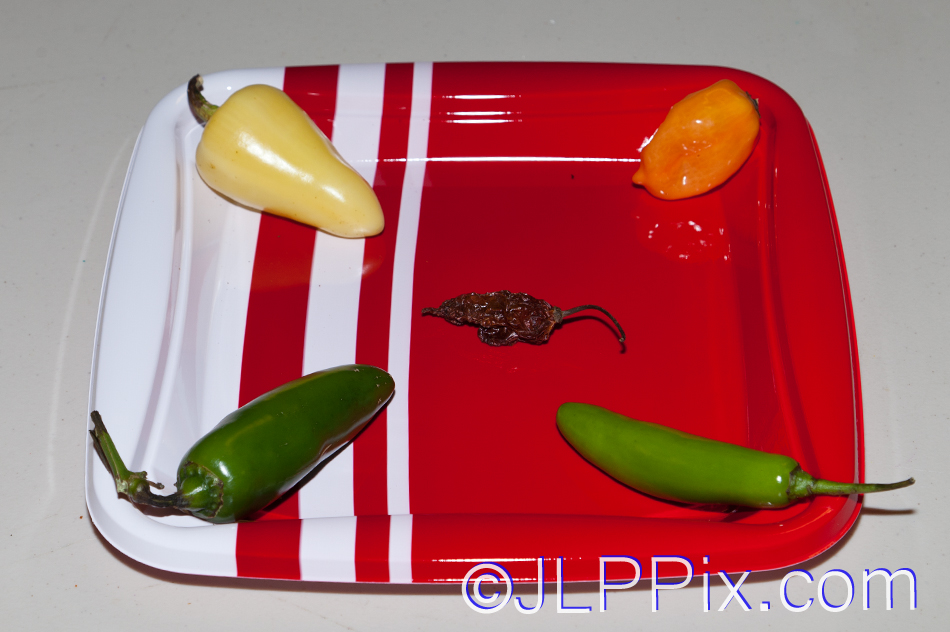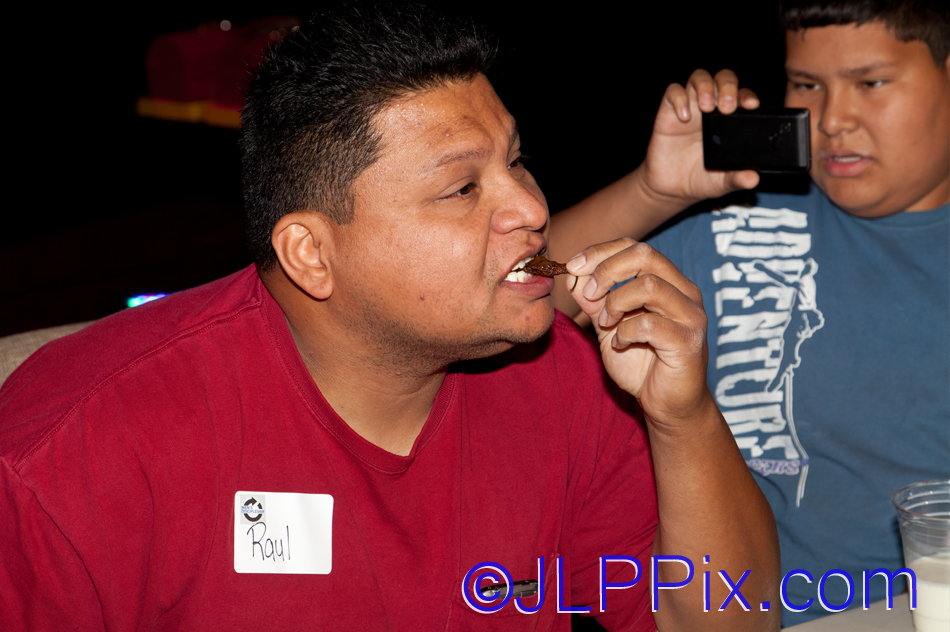Hot, Hot, Hot – July 15, 2013
Lower left hand corner, jalapeno, clockwise yellow wax, habanero, serrano, and the ghost pepper is in the middle.
Seven willing victims.
Randy looking a little worse for the wear.
Raul taking a bite out of the ghost pepper that was marinated in ghost pepper hot sauce.
Above are some images of the PVC Mens Ministry Chile Pepper eating contest. This was held June 22, 2013. We had 7 willing contestants. I had prepared a plate with a jalapeno pepper, which was the mildest pepper coming in at around 5,000 scoville heat units. The second pepper was the yellow wax hot pepper, which comes in at a respactable 10-15,000 scoville rating. Third was the seranno pepper, ranging from 15-23,000 scoville rating. Fourth on the list was my friend the habanero pepper, which ranges from 100-350,000 scoville rating. The fifth pepper was a dried “ghost” pepper (Naga Bhut Jolokia). These peppers were unknown until around 2007. Their scoville rating is over 1,000,000. This was not a timed event. I was impressed with all of the contestants efforts. Randy was the first done at each phase including the “ghost” pepper. I had a bonus ghost pepper that had been soaking in my hottest hot sauce for 30-45 minutes. randy opted out, and had a glass of milk. Big Raulwas a little slower getting there, but he also finished all 5 peppers, and took a bite of the bonus pepper. Raul also seemed calm, relaxed, and did not break a sweat. In watching, I broke out in a sweat, as if I too was partaking. All were good sports.
Below is some information about scoville heat units, and high performance liquid chromatography (HPLC) from Wikipedia.
The Scoville scale is the measurement of the pungency (spicy heat) of chili peppers.
The number of Scoville heat units (SHU) indicates the amount of capsaicin present. Capsaicin is a chemical compound that stimulates chemoreceptor nerve endings in the skin, especially the mucous membranes.
The scale is named after its creator, American pharmacist Wilbur Scoville. His method, devised in 1912, is known as the Scoville Organoleptic Test. In Scoville’s method, a measured amount of alcohol extract of the capsaicin oil of the dried pepper is produced, after which a solution of sugar and water is added incrementally until the “heat” is just barely detectable by a panel of (usually five) tasters; the degree of dilution gives its measure on the Scoville scale. Thus, a sweet pepper or a bell pepper, containing no capsaicin at all, has a Scoville rating of zero, meaning no heat detectable. The hottest chilis, such as habaneros and nagas, have a rating of 200,000 or more, indicating their extract must be diluted over 200,000 times before the capsaicin presence is undetectable. The greatest weakness of the Scoville Organoleptic Test is its imprecision, because it relies on human subjectivity. Tasters taste only one sample per session. Results vary widely, up to 50%, between laboratories.
The modern commonplace method for quantitative analysis uses high-performance liquid chromatography, making it possible to directly measure capsaicinoid content. Spice heat is usually measured by a method that uses high performance liquid chromatography (HPLC). This identifies and measures the concentration of heat-producing chemicals. The measurements are used in a mathematical formula that weighs them according to their relative capacity to produce a sensation of heat. This method yields results, not in Scoville units, but in American Spice Trade Association (ASTA) pungency units. A measurement of one part capsaicin per million corresponds to about 15 Scoville units, and the published method says that ASTA pungency units can be multiplied by 15 and reported as Scoville units. This conversion is approximate, and spice experts Donna R. Tainter and Anthony T. Grenis say that there is consensus that it gives results about 20–40% lower than the actual Scoville method would have given.




Leave a Reply